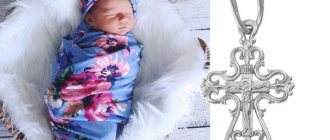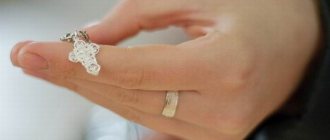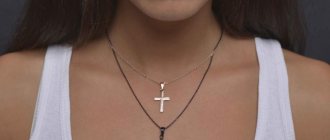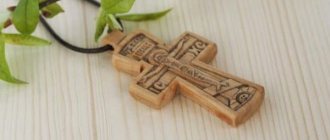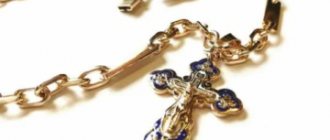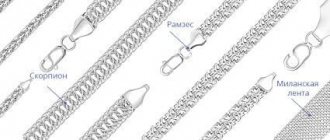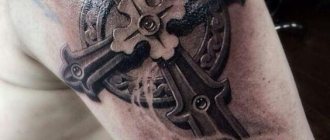Audio version of the article
- History of the Holy Cross K. Parkhomenko
- About the sign of the cross and pectoral crosses Answers to questions
- Holy cross K. Slepinin
- Is it possible to remove a pectoral cross? Deacon Sergius Shalberov
- Truth and myths about the pectoral cross of Rev. Nikolay Markovsky
- Breviary. The rite of blessing the cross to be worn on the chest
- Photo story “Pectoral Cross”
***
A pectoral cross is a small cross that symbolically displays the Cross on which the Lord Jesus Christ was crucified (sometimes with the image of the Crucified One, sometimes without such an image), intended to be constantly worn by an Orthodox Christian as a sign of his faith and fidelity to Christ, belonging to the Orthodox Church, serving as a means for grace-filled protection.
The cross is the greatest Christian shrine, a visible evidence of our redemption. In the service for the Feast of the Exaltation, the Church glorifies the tree of the Cross of the Lord with many praises: “The Cross is the guardian of the entire universe, the beauty of the Church, the power of kings, the affirmation of the faithful, the glory of angels and the plague of demons.”
A pectoral cross is given to a baptized person who becomes a Christian and is constantly worn in the most important place (near the heart) as an image of the Cross of the Lord, an external sign of an Orthodox Christian. This is also done as a reminder that the Cross of Christ is a weapon against fallen spirits, having the power to heal and give life. That is why the Cross of the Lord is called Life-Giving!
He is evidence that a person is a Christian (a follower of Christ and a member of His Church). This is why it is a sin for those who wear a cross for fashion without being a member of the Church. Consciously wearing a cross on the body is a wordless prayer, allowing this cross to demonstrate the true power of the Archetype - the Cross of Christ, which always protects the wearer, even if he does not ask for help, or does not have the opportunity to cross himself.
When performing the sacrament of Baptism, the priest puts a cross on the baby, which from that moment becomes the inseparable companion of the new member of the Church. It is not customary to remove a cross when bathing or changing clothes (in the old days there were even wooden crosses in the baths, which were worn in the steam room instead of their own). Unfortunately, there are also “knowledgeable” advisers: nurses, neighbors, friends who authoritatively convince the mother to remove the cross from the child: they say he is still small, he will get tangled in the ribbon, he will chafe the skin, etc.
There are canonical forms of crosses - four-, six-, eight-pointed; with a semicircle below and others. Each line has a deep symbolic meaning. In Rus', eight-pointed crosses are more common, on the back of which, according to tradition, the inscription “Save and Preserve” is written. Saint Demetrius of Rostov wrote back in the 18th century: “We reverence the Cross of Christ not by the number of trees, not by the number of ends, but by Christ himself, whose Most Holy Blood was stained with Him. Displaying miraculous power, any Cross does not act by itself, but by the power of Christ crucified on it and by invoking His Most Holy Name.”
There are no rules about the material for crosses. Obviously, precious metals are also acceptable here, because for a Christian nothing can be more valuable than a cross - hence the desire to decorate it. But, of course, simple wooden or metal crosses are closer in spirit to the Cross of the Lord. There is also no fundamental difference between a chain and a braid: it is important that the cross is held firmly. The cross should not be removed, incl. during washing and sports activities. Lay people wear a cross (on the body) under their clothes, without deliberately showing it off.
In the first centuries of Russia’s adoption of Christianity, crosses were worn not on the body, but on top of clothing “as clear indicators of Christian baptism.” Later, only bishops had the right to wear a cross over their clothes until the 18th century, and even later – priests. The priestly pectoral cross is called a pectoral cross (“persi” in Church Slavonic means “chest”). Along with the pectoral, priests also wear a pectoral cross.
Russian people swore allegiance on crosses, and by exchanging pectoral crosses, they became cross brothers. When building churches, houses, and bridges, a cross was laid in the foundation. There was a custom to cast many crosses from a broken church bell, which were especially revered. Taking off one's cross or not wearing it has always been understood as apostasy. Over the 2000-year history of Christianity, many people have suffered for their faith, for refusing to renounce Christ and take off their pectoral cross. This feat has been repeated in our time.
There are many superstitions associated with the pectoral cross : if you lose the cross, disaster will happen; a cross lost by someone cannot be picked up; a cross cannot be given as a gift, worn on a chain, and the like. All of them have no basis: you can buy a new cross, wear one that was given or found, and consecrate it in the temple. Those crosses that are sold in the temple are consecrated with a special rite.
***
How to choose a pectoral cross?
A pectoral cross is not a piece of jewelry. No matter how beautiful it may be, no matter what precious metal it is made of, it is first and foremost a visible symbol of the Christian faith.
Orthodox pectoral crosses have a very ancient tradition and therefore are very diverse in appearance, depending on the time and place of manufacture. The traditional Orthodox pectoral cross has an eight-pointed shape.
The veneration of the cross and love for it is manifested in the richness and variety of its decorations. Pectoral crosses have always been distinguished by their diversity both in the choice of material from which they were made - gold, silver, copper, bronze, wood, bone, amber - and in their shape. And therefore, when choosing a cross, you need to pay attention not to the metal from which the cross is made, but to whether the shape of the cross corresponds to Orthodox traditions, which will be discussed below.
Strict canons and variety of forms
According to the number of rays, the cross can be four-pointed, six-pointed, seven or eight-pointed.
- The four-pointed symbol of faith appeared in the 3rd century; it is still considered acceptable for the Orthodox. In the Greek type, the crosshairs are of equal length; in the Latin type, the vertical post is longer than the transverse one.
- Six-pointed cross - “Russian Orthodox”. It has a bottom bar, but no top bar. This symbol is not very popular now.
- The seven-pointed crucifix is a rare phenomenon for modern Orthodoxy. You can see it in the photos of preserved ancient temples.
- Eight-pointed is the most common type of decoration. The crucifix has three crossbars: a small upper one, a middle one, and an oblique lower one. According to spiritual sources, when Christ carried the cross, it was four-pointed; before the crucifixion, the foot appeared, and only after - the head.
Thus, almost all types of crosses can be considered reliable and acceptable for the Orthodox tradition.
In historical literature there are other forms: T-shaped, anchor, with a crown of thorns in the middle, but they are not used for the production of Orthodox crosses, but serve only as a source of inspiration for jewelers.
A body crucifix is a traditional, iconic form of jewelry, but you can choose a beautiful accessory with an image and a decorative interpretation of the rays.
- The petal cross looks like an inflorescence with rays expanding towards the edges. This ancient form dates back to Byzantium and is considered traditionally Orthodox. This is exactly the symbol that was installed during the baptism of Rus'. Petal decoration was previously considered feminine due to its rounded natural outlines.
- The teardrop shape is also common. The droplets on the half-arcs at the 4 ends symbolize drops of blood.
- The trefoil cross is characterized by trefoil-shaped thickenings at the ends. This is what an altar cross might look like; trefoil body decorations are rare.
Is it possible to wear crosses with a Catholic Crucifix?
The iconography of the Orthodox Crucifixion received its final dogmatic justification in 692 in the 82nd rule of the Trull Cathedral, which approved the canon of the iconographic image of the Crucifixion. The main condition of the canon is the combination of historical realism with the realism of Divine Revelation. The figure of the Savior expresses Divine peace and greatness. It is as if it were placed on a cross and the Lord opens His arms to everyone who turns to Him.
In this iconography, the complex dogmatic task of depicting the two natures of Christ - Human and Divine - is artistically solved, showing both the death and the victory of the Savior. Catholics, having abandoned their early views, did not understand and did not accept the rules of the Council of Trull and, accordingly, the symbolic spiritual image of Jesus Christ.
Thus, in the Middle Ages, a new type of Crucifixion emerged, in which the naturalistic features of human suffering and the agony of execution on the cross became predominant: the weight of the body sagging on outstretched arms, the head crowned with a crown of thorns, the crossed feet nailed with one nail (an innovation at the end of the 13th century). The anatomical details of the Catholic depiction, while conveying the veracity of the execution itself, nevertheless hide the main thing - the triumph of the Lord, who defeated death and reveals to us eternal life, and concentrates attention on torment and death. His naturalism has only an external emotional impact, leading to the temptation of comparing our sinful sufferings with the redemptive Passion of Christ. Images of the crucified Savior, similar to Catholic ones, are also found on Orthodox crosses, especially often in the 18th–20th centuries, however, as well as iconographic images of God the Father prohibited by the Stoglavy Cathedral. Naturally, Orthodox piety requires the wearing of an Orthodox cross, and not a Catholic one, which violates the dogmatic foundations of the Christian faith.
Forms of body crucifixes
In addition to the existing differences in form, the Orthodox Crucifixion of Christ also differs in type. Here is a list of the most famous types of symbolism:
- Eight-pointed symbol. Today, the eight-pointed cross is considered the most common, and initially it had the usual equilateral shape, but after the crucifixion of Jesus Christ on it, it was changed.
- St. George's symbol. It was approved by Catherine the Great as a decoration for officers and priests. It is a symbol of the most regular shape, with four sides.
- Seven-pointed Crucifixion of Christ. Most often used for divine images created in the 15th century.
- Crown of thorns. Made in the form of a cross with a thorny crown, denoting the suffering and torment of Christ.
How to consecrate a pectoral cross?
Traditionally, in the Orthodox Church, the consecration of the pectoral cross is performed by a clergyman in the church. The rite of blessing the cross to be worn on the forehead, i.e. on the chest, contained in the liturgical book - Trebnik.
The cross is consecrated only once. It needs to be reconsecrated only in exceptional conditions (if it was severely damaged and restored again, or fell into your hands, but you do not know whether it was consecrated before).
There is a superstition that when consecrated, the cross acquires magical protective properties. The Church teaches that the sanctification of matter allows us not only spiritually, but also physically - through this sanctified matter - to join the Divine grace that we need for spiritual growth and salvation. But the grace of God does not act unconditionally. A person is required to have a correct spiritual life according to God’s commandments, and it is this spiritual life that makes it possible for God’s grace to have a salutary effect on us, healing us from passions and sins.
Sometimes you hear the opinion that the consecration of crosses is a late tradition and that this has never happened before. To this we can answer that the Gospel, as a book, also once did not exist and there was no Liturgy in its current form. But this does not mean at all that the Church cannot develop forms of worship and church piety. Is it contrary to Christian doctrine to invoke God’s grace on the creation of human hands?
What material should the cross be made of?
Traditionally, the material your creed is made from is not important. During baptism, you can even wear jewelry made of wood or copper. But the variety of modern models and replicas of ancient jewelry allows everyone to choose a cross to their liking and budget. You can choose jewelry from a photo or come to the store yourself.
- A silver crucifix is the most common type of canonical pendant. Silver is a worthy alternative to any base metal, because it does not cause allergies when in contact with the skin. It’s good to buy silver crosses for children without worrying about expensive jewelry.
- A gold accessory is a good choice if silver glitter seems too simple and inappropriate for such an important symbol.
- Combined metals are often used in modern interpretations of ancient forms. For example, the base could be made of silver or white gold, and the image of the crucifix could be gold.
- You will like inlay with precious stones if you love the luxury of Byzantine ornaments, golden domes, and shining icons. Then you should choose a pectoral cross with bright multi-colored stones, everyday cubic zirconia or noble diamonds.
It doesn’t matter which cross you ultimately choose, it is important that it truly becomes a symbol of faith and religious tradition for you.
How to distinguish between Orthodox and Catholic crosses
Form and text
In the Orthodox Church, the most common are six- and eight-pointed crosses.
The latter have long been considered a powerful amulet against evil spirits. The crossbar in the heads symbolizes the sign that was used to mark the crimes committed. But since no one called the crimes of Jesus that way, in the Orthodox tradition it may have the abbreviation I.N.C.I. or I.N.C.I, Catholics write INRI in Latin. This is an abbreviation for “Jesus of Nazareth, King of the Jews
. The slanting crossbar under your feet symbolizes the path from sins to righteousness. In turn, Catholic pectoral crosses are as simple as possible and consist of only two crossbars with or without a crucifix.
Engravings
In addition to the inscription I.N.Ts.I., on Orthodox crosses, on the side opposite the crucifix,
“Save and Preserve”
. There is no such thing in the Catholic tradition.
Nails Orthodox Christians believe that Jesus was nailed by four
nails, and Catholics - that there were only
three
. That is why the feet of Christ on the Orthodox cross are located side by side, but on the Catholic cross they are thrown one on top of the other.
Crucifixion How Jesus should be depicted on the crucifix is a subject of heated debate among representatives of both faiths. Catholics adhere to the most naturalistic image, which reflects the insane suffering on the cross. At the same time, the Orthodox believe that such an image speaks of torment, but is silent about the main thing - Jesus conquered death. Therefore, in the Orthodox tradition, his figure rather reflects happiness from the transition to a better world.
Gold cross or silver?
There are no strict church regulations in this regard. Naturally, a gold cross is preferable, since yellow aurum is a bioinert material that does not cause allergies. In addition, such metal does not oxidize and does not darken.
A golden cross looks more magnificent and festive. Products in silver are strict and laconic. They shimmer discreetly in the light. However, this is precisely why some people like them.
Silver is credited with strong protective properties. It is believed that a talisman made of this metal best protects against the evil eye.
Advice from YuK : For daily wear, it is better to choose 585-carat aurum or silver. These metals are the least allergenic, retain their original appearance longer and rarely become deformed.
Symbolism of the main Orthodox crosses
Eight-pointed cross
This is one of the most canonical Orthodox crosses. There is a short horizontal crossbar (often with the abbreviation I.N.Ts.I.) on top, and a short diagonal crossbar at the feet (the upper end is directed to the left, the lower end is directed to the left, if you look at the cross directly). The lower part is a symbol of support under the feet of the crucified Jesus, as well as the transition from a sinful world to a righteous one. In fact, the presence of this false support only prolonged the torment on the cross.
Six-pointed cross
One of the oldest options. In this cross, the inclined lower crossbar symbolizes the internal scales of each of us: what wins - conscience or sin. Its meaning is also interpreted as the path from sin to repentance.
Four-pointed teardrop cross
It is believed that the drops at the ends of the crossbars are the blood of the crucified Christ, who atoned for the sins of mankind.
This symbol is often used to decorate religious books. “Shamrock”
This cross is often used in heraldry (for example, on the coat of arms of Chernigov), but many people also love it as a body cross.
The ends of the crossbars of such a product are decorated with semicircular leaves. Sometimes there are also beads on them - “bumps”
.
Latin four-pointed cross The most common Christian cross in the West. The horizontal crossbar is located 2/3 of the height from the vertical one. The elongated lower part symbolizes Christ's patience in redemption.
Women's and men's crosses
There is no significant difference between crosses for men and women, but there are products that are universal in design and are equally suitable for everyone. The main difference is in the decor and size. Women's crosses are often inlaid with precious stones, while men's crosses are decorated with blackening. But the decor does not in any way affect the sacred meaning of the symbol of faith. The rest is a matter of taste.
It is expected that from the moment of consecration , the cross will remain with you forever. But the church does not condemn the change of this decoration in any way. By the way, wearing it on the same chain with another pendant is bad manners. The only thing that can be worn with a cross is an amulet.
How to consecrate a cross
Crosses purchased in church shops have two advantages. Firstly, they exactly correspond to the traditions of your religion. Secondly, they are already sanctified. If you bought a cross in a jewelry store, then it must be blessed. It is better to come before the start of the service and make this request to the priest. You can also ask him to perform the ceremony in your presence and take part in prayer.
What to do if you find a cross? There is an opinion that finding a cross is a bad omen. Allegedly, along with it, the sorrows and sorrows of the previous owner may be passed on to you. At the same time, the church advises not to pay attention to such superstitions.
Is it possible to give a pectoral cross? It is possible and necessary. The Church does not prohibit this. And for a loved one such a gift will be especially important and dear.
Share in the comments whether you were interested in the Zlato.ua article. Tell us, what shape of crosses do you prefer? And what does a cross mean to you - a decorative decoration or something more?
Which form should I choose?
The most common form of pectoral crosses is eight- and four-pointed. The first are fully consistent with the Orthodox canons, the second - with the Catholic canons. A traditional Orthodox cross is engraved on one side with a crucifix and on the other with the words “Save and Preserve.” Catholic priests accept crosses without crucifixes or inscriptions. The crossbars can be clearly rectangular, turning into a trefoil or a drop at the ends.
It is better for men and boys to choose simple, laconic crosses without additional decor. For women and girls, a cross with beautiful engraving, multi-colored gold inserts, and colored stones is suitable.
Crosses of non-standard shape (curved, round, with a rectangular base and rounded top, decorated with flowers, drops and petals) are an elegant decoration and nothing more. Although in fact it is much more important how the owner of the cross feels when putting it on. If you feel that it warms your soul, do not pay attention to the advice. Only you know how great your faith in God is.
The round and oval shapes of the cross soften the image and give it some delicacy. A contrasting black background will make the cross a more visible detail.
No decorations
